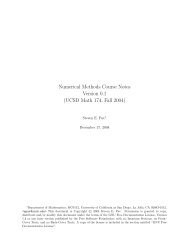Application of Modern Dynamic Software to Fermat's Problem
Application of Modern Dynamic Software to Fermat's Problem
Application of Modern Dynamic Software to Fermat's Problem
You also want an ePaper? Increase the reach of your titles
YUMPU automatically turns print PDFs into web optimized ePapers that Google loves.
<strong>Application</strong> <strong>of</strong> <strong>Modern</strong> <strong>Dynamic</strong> S<strong>of</strong>tware <strong>to</strong> Fermat’s<br />
<strong>Problem</strong><br />
Jordan Tabov<br />
(joint work with Nevena Koleva)<br />
The Fermat <strong>Problem</strong> is not only challenging but gives good opportunities for application<br />
<strong>of</strong> different classical and modern ideas and techniques and therefore is suitable<br />
for the work with talented students. Here we show how it can be reduced <strong>to</strong> a relatively<br />
simple problem involving angles, a problem, which can be investigated by<br />
some modern dynamic s<strong>of</strong>tware like GeoGebra, and even can be used for demonstrating<br />
the power <strong>of</strong> the modern modeling computer <strong>to</strong>ols in geometrical research.<br />
Recall that the general Fermat <strong>Problem</strong> can be formulated in the following way.<br />
Given a triangle ABC and real numbers l, m and n, determine the minimal value <strong>of</strong><br />
the function F (X) = l · XA + m · XB + n · XC, where X is a variable point which<br />
ranges in the entire plane <strong>of</strong> the triangle ABC.<br />
When the coefficients l, m and n are positive numbers, some <strong>of</strong> the most efficient and<br />
beautiful methods for attacking it - using respectively spiral homothety, circumscribed<br />
triangle, P<strong>to</strong>lemy’s Theorem, complex numbers, mechanical approach - are presented<br />
in many articles and books, <strong>of</strong> which here we quote some <strong>of</strong> the most interesting and<br />
useful ones: Jalal and Krarup [1], Shay and Tessler [2], H<strong>of</strong>mann [3], Courant and<br />
Robbins [4], Ganchev and Nikolov [5].<br />
In the present paper we consider the case when l, m and −n (n < 0) are positive<br />
numbers. The Fermat <strong>Problem</strong> with one negative and two positive coefficients can be<br />
reduced <strong>to</strong> the case with positive coefficients, as it is done in [5], or can be solved using<br />
methods <strong>of</strong> classical geometry (as in [1]). Here we apply a functional approach (the<br />
idea <strong>of</strong> this approach appeared in Tabov [6]).<br />
Keywords: Fermat <strong>Problem</strong>, dynamic s<strong>of</strong>tware.<br />
References<br />
[1] G. Jalal, J. Krarup, Geometrical solutions <strong>to</strong> the Fermat problem with arbitrary<br />
weights, Annals <strong>of</strong> Operations Research 123 (2003), 67–104.<br />
[2] G. Shay, R. Tessler, The Fermat-Steiner <strong>Problem</strong>, Am. Math. Monthly 109<br />
(2002),<br />
443–451<br />
[3] E. H<strong>of</strong>mann, Elementare Losung einer minimumsaufgabe, Zeitschrift fur mathematischen<br />
und naturwissenschaftlichen Unterricht, 60 (1929), 22–23<br />
[4] Courant, R., H. Robbins. What is Mathematics? Oxford University Press, New<br />
1
2<br />
York, 1951<br />
[5] G.Ganchev, N. Nikolov, Isogonally conjugated points and Fermat’s <strong>Problem</strong>,<br />
Matematicheskoe prosveshchenie, 12 (2008), 185–194. (In Russian)<br />
[6] J. Tabov, Solution <strong>to</strong> <strong>Problem</strong> 866 (proposed by J. Dou), Crux Mathematicorum,<br />
10 (1984), 327–329<br />
Institute <strong>of</strong> Mathematics and Informatics Bulgarian Academy <strong>of</strong> Sciences














